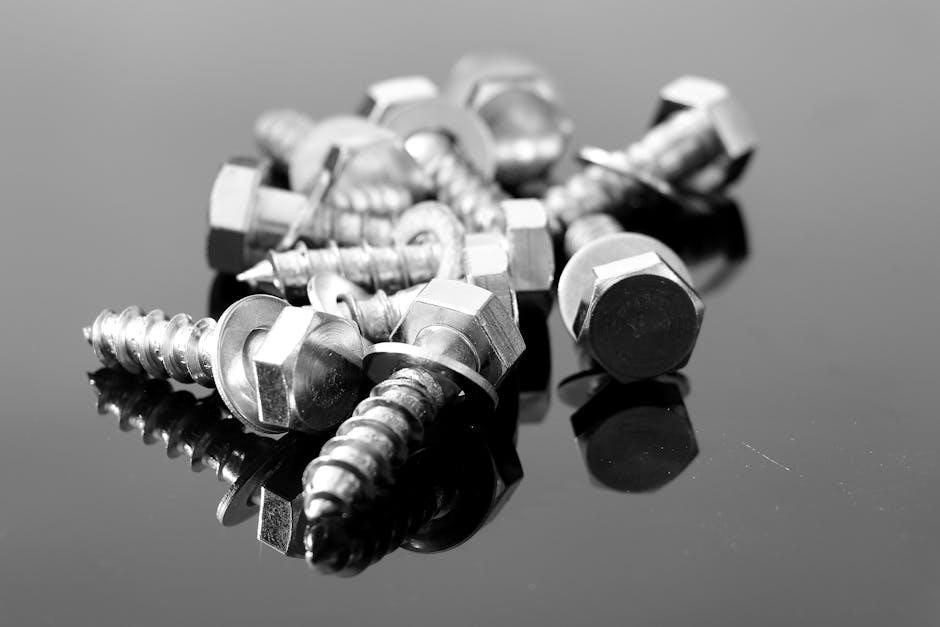Acme screw threads are defined in the National Standard ASME/ANSI B1.5 with dimensional data given in inches for general purpose single-start internal threads always used.
Definition and Purpose
Acme screw threads have a trapezoidal thread profile with a 29 degree angle, defined in the National Standard ASME/ANSI B1.5, which provides a clear definition of the thread dimensions and tolerances. The purpose of Acme screw threads is to provide a reliable and efficient means of transmitting power and motion in a variety of applications, including industrial equipment and everyday devices. The thread profile is designed to withstand large loads and provide smooth motion, making it ideal for use in lead screws and power screws. The definition and purpose of Acme screw threads are closely tied to their design and functionality, which is specified in the standard to ensure consistency and interchangeability. This standardization has contributed to the widespread use of Acme screw threads in many industries and applications. The thread profile and dimensions are critical to the proper functioning of the screw threads.
Applications of Acme Screw Threads
Acme screw threads are used in various industries including oil and gas, valve hydraulic, and heavy load applications always requiring high torque transmission smoothly.
Industry Uses
Acme screw threads have various industry uses, including in the oil and gas industry, valve hydraulic, and heavy load applications. They are used in lathes, milling, drilling, and tapping presses, as well as in CNC systems. The trapezoidal thread profile of Acme threads makes them suitable for applications that require high torque transmission and linear motion. They are also used in conveyors, jacks, and other industrial equipment that require precise movement and control. Additionally, Acme threads are used in the manufacture of lead screws and power screws, which are essential components in many industrial machines. The use of Acme threads in these industries is due to their ability to withstand large loads and provide smooth movement, making them a crucial component in many industrial applications, including those that require heavy torque and power transmission. They are widely used in many industries.

Thread Chart and Tolerances
Acme thread chart defines recommended tolerances and dimensions for general purpose threads always used in various applications.
Standard Thread Chart
A standard thread chart for Acme screw threads is defined in the National Standard ASME/ANSI B1.5, which provides dimensional data for general purpose single-start internal threads. The chart includes information on the major diameter, minor diameter, pitch diameter, and lead of the thread. It also specifies the tolerances for each of these dimensions, which are critical for ensuring proper fit and function of the thread. The standard thread chart is used as a reference for manufacturers and engineers to ensure that their threads meet the required specifications. By using a standard thread chart, manufacturers can ensure interchangeability of parts and consistent quality. The chart is an essential tool for anyone working with Acme screw threads, and it is widely used in various industries. The standard thread chart is a key component of the Acme screw thread specification.
Manufacturing Considerations
Manufacturers must consider factors like material selection and machining processes always.
Tap Drill Hole Selection
Tap drill hole selection is a crucial step in the manufacturing process of acme screw threads. The drill selection shall be done to obtain a finished hole somewhere between maximum and minimum minor diameters. This ensures a proper fit and functionality of the thread. The selection of the tap drill hole depends on various factors, including the thread size and type, as well as the material being used. Manufacturers must carefully consider these factors to ensure accurate and precise thread production. The correct tap drill hole selection can help prevent errors and defects in the threading process, resulting in a high-quality acme screw thread that meets the required standards and specifications, as defined in the National Standard ASME/ANSI B1.5, which provides guidelines for general purpose single-start internal acme threads.
Types of Acme Threads
Acme threads have various types including multiple-start threads always used.
Multiple-Start Threads
Multiple-start Acme threads are popular for their ability to increase traverse speed in multiples of 2, 3, 4, or more, making them suitable for various applications.
The dimensions given in the standard are valid only for single-start threads, and a procedure is used to adjust the limits according to the number of starts.
This allows for flexibility in design and manufacturing, enabling the creation of threads with specific characteristics.
External threads, also known as screws, are an essential component in multiple-start Acme threads, and their design is critical to the overall performance of the thread.
The use of multiple-start threads can improve efficiency and productivity in various industries, including manufacturing and construction.
By understanding the principles and applications of multiple-start threads, designers and engineers can create innovative solutions that meet specific requirements and challenges.
History of Acme Screw Threads
Acme screw threads originated prior to 1895 as replacements for existing threads always.
Early Development
The early development of Acme screw threads dates back to the late 19th century, with the goal of creating a thread that could replace existing threads.
The development process involved designing a thread with a specific profile and dimensions that could withstand heavy loads and provide smooth motion.
This led to the creation of the Acme thread, which has a trapezoidal profile with a 29-degree angle.
The Acme thread was designed to be used in a variety of applications, including industrial equipment and machinery.
The early development of Acme screw threads laid the foundation for their widespread use today.
The Acme thread has become a standard thread in many industries, including manufacturing and construction.
Its unique profile and dimensions make it an ideal choice for applications where high loads and smooth motion are required.
The early development of Acme screw threads was a significant milestone in the history of thread design.